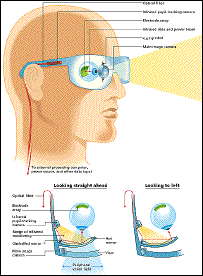
RELATED RESEARCH TOPICS:

AUDIO DISPLAY FOR THE BLIND (1976):
-
Patterns, shapes are presented to the blind person
in the form of sound through ear-phones.
-
Listeners imagine a dot of sound moving in front
of them. The vertical loaction of the dot was directly rellated to the
pitch of the sound (since for tones below 7kHz a higher pitch is perceived
as coming from a higher vertical position), and the horizontal position
through the use of binaural hearing.
-
With little training, patterns and shapes can be
correctly determined.
-
This idea was later modified allowing a camera to
obtain an image which was then scanned. When thwe scan is on the desired
object, the methods above are used to convey the information to the subject.
-
Simple and complex shapes, as well as patterns were
successfully determined.
CONTOUR PERCEPTION SYSTEM (KONWA) (1988):
-
Prototype mobility aid to allow for better orientation
and object recognition.
-
User moves an optical sensor which reduces an object
to its outlines (which is the essential information necessary for object
recognition). the contour informationis transferred to the forearm of the
user via electrical pulses. Two weak pulses signal a contour line and its
direction. Two stimuli indicate the direction of the contour.
-
By moving the forearm, the contour can be tracked
(through the presence of the stimuli), allowing a mental image of the figure
to be developed which may be rocognised by the user depending on past experiences.
VIBROTACTILE AND ELECTROCUTANEOUS OUTPUT:
-
Covert visual informnation obtained through a camera
into a pattern on a matrix of stimulators which are in contact with the
skin. The stimulators aither vibrate or release electric current creating
a sensation on the skin.
-
Not very promising for mobility uses.
TVSS (TACTILE VISUAL SUBSTITUTION SYSTEM) (1969):
-
Converts visual information obtained with a camera
into a pattern of vibrations or electrical stimulations on a matrix in
contact with the user's back or abdomen.
-
Experimented with a staionary camera (yielding poor
results), hand held and spectacle mounted camera.
-
When an object is introduced for the first time the
user is told what it is in hopes of being able to recognise the same object
in the future.
-
Can learn to scan the object in order to find distinct
features as cues to identification.
-
After several hours of practice, subjects were able
to identify reliably, randomly presented objects (from a set of 25), in
an average of 10s.
PATTERN RECOGNITION ON THE FOREHEAD: ELECTRIC
SCAN SYSTEM
-
The following improve perception of a pattern:
-
'Flashing' the pattern presented to the skin ON/OFF.
-
Moving the pattern across the array (serial stimulation).
-
Only a narrow portion of the pattern is activated
at any one time.
-
Cutaneous and auditory modalities can process information
serially better.
-
Same idea as the TVSS, however a 10 * 10 matrix was
used on the forehead (since the back and abdomen have poor 'two-point'
descrimination and the area on the fingertips is too small to provide efficiency),
incorporating the above three considerations.
-
Serial stimulation achieved by activating the appropriate
stimulators of each row in a left to right manner starting from the top
row.
-
Provided better results than the TVSS.
MODIFIED OPTACON:
-
Camera with 144 cells (6 * 24), which are directly
connected to the stimulators (vibrotactile array finger pad).
-
Any pattern on the camera's array is immediately
transfered to the finger pad (in contacct with the user's finger).
-
Camera is head mounted allowing the user to scan
for objects.
64 SOLENOID, FOUR LEVEL FINGERTIP SEARCH DISPLAY
FOR THE THE BLIND (1986):
-
Information of a camera image is conveyed to the
finger through varying stimulations taking advantage of the blind person's
skill of exploring with their fingertips.
-
Goal of the device:
-
High spatial resolution by keeping elements of the
array closely spaced.
-
More than two shades (grey scale - not just ON/OFF).
-
IBM-PC controlled.
-
Non-vibrating, comfortable with fast response time.
-
Used an 8 * 8 array of dc solenoids allowing for
four different heights (each height corresponding to a level on the grey
scale).
-
The PC obtains the image from the camera (or the
image may be stored in memory), and passes an 8 * 8 portion of the image
to the display.
-
user uses the mouse to select the portion of the
image they wish to examine.
 CORTICAL STIMULATION:
CORTICAL STIMULATION:
-
Generation of light flash sensations by electrically
stimulating the visual cortex through an implanted array of stimulators
corresponding to the image picked up by the camera.
-
Although several implants have been performed, this
field requires much research. Several implants performed during the 70s
were very long and complicating. The devices usually malfunctioned with
time.
-
See IEEE
Spectrum May 1996 for a thorough description of some current work in
this field
TALKING SIGNS
-
Conveys printed sign information (used by the sighted
population to aid in orientation), in the form of audio (speech).
-
"Talking Signs do for print- handicapped persons
what printed signs do for those able to read them. They are small, inexpensive
voice-modulated infrared transmitters whose message is heard by means of
a pocket-size receiver which speaks the Signs' messages and indicates the
direction of their source. ". (The
Smith-Kettlewell Eye Research Institute)
ORIENTATION
BY PERSONAL ELECTRONIC NAVIGATION - OPEN - (1997):
-
'Bracons' which continuously transmit audible (speeh)
messages are placed in public places (e.g. bus and train stations),.
-
A user within this environment with a receiver will
receive this message which gives information regarding the environment
and direction.
-
Messges are transmitted in four different languages
and the user may choose either.
-
The messages conveyed by the beacons can easily be
changed (e.g. the beacons are networked allowing any one beacon to be accessed
from a central control location).



![]()